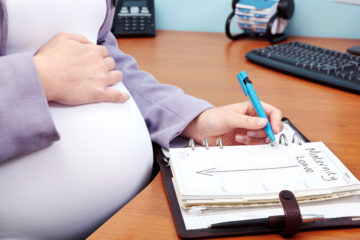Pregnancy should be a positive and exciting time. It is also a time when information and support is needed and questions may arise.
The NASUWT is committed to supporting you throughout this time, ensuring that you receive the advice you need about what pregnancy will mean for your job.
This guidance provides you with key information about your rights at work while you are pregnant.
To qualify for maternity rights, you must:
-
have a contract of employment;
-
notify your employer you are pregnant at least 15 weeks before the expected week of the birth, confirming the date your baby is due and the date you want your maternity leave to start. You can decide to change this date later, if you give at least 28 days’ notice;
-
have worked for your employer continuously for at least 26 weeks prior to the ‘qualifying week’ (i.e. 15 weeks before the Expected Week of Childbirth);
- these are usually issued after you have been pregnant for 21 weeks.
Once you have notified your employer of your pregnancy, your employer must then write to you within 28 days, confirming the date you have agreed to return after your maternity leave.
Your contractual rights
Your employer may have a maternity policy which is better than the statutory entitlements. You are entitled to a copy of the policy.
It is important to check your contract of employment and request a copy of your employer’s policy.
England and Wales
The Conditions of Service for School Teachers in England and Wales (Burgundy Book, see link right/below) sets out national conditions of service for school teachers in England and Wales and is an essential reference for all maintained schools, as well as non-maintained schools that choose to incorporate this agreement into their teachers’ contracts of employment.
The Burgundy Book’s main provisions relate to notice periods, sick leave and pay and maternity leave and pay. It enhances the statutory maternity scheme for teachers who have one year’s continuous service at the beginning of the 11th week before the Expected Week of Childbirth (EWC).
These enhanced maternity provisions apply to teachers working in local authority-maintained schools and those who have transferred (under TUPE) to an academy. You should also be eligible if you work in an academy which has a contract specifying the Burgundy Book.
Northern Ireland
In Northern Ireland, there is a maternity policy that covers every Grant Aided School (TNC 2015/2). Further information is available on our Northern Ireland Maternity, Paternity and Adoption Leave page (linked right/below).
Scotland
In Scotland, you should refer to the Scottish Negotiating Committee for Teachers (SNCT) if you are employed by the local authority. Further information is available on our Scotland Maternity, Paternity and Adoption Leave page (linked right/below).
Antenatal appointments
You are entitled to reasonable paid time off to attend antenatal appointments. Keep details of any antenatal appointments in case your employer asks to see them.
Sickness absence
Sickness absence during your pregnancy, whether connected with your pregnancy or not, should be treated as ordinary absence on sick leave.
However, if you take sick leave for pregnancy-related reasons in the last four weeks before the expected week of childbirth, your employer can require you to start your maternity leave early.
Risk assessment
During your pregnancy, your employer is required to carry out an initial risk assessment of your job and working environment, examining any risks that might affect you or your unborn child.
Your employer is required to confirm that a risk assessment has been undertaken. You should be given a copy of the risk assessment.
Further assessments should be undertaken if your job or working environment changes in any way.
If any risks are identified as part of the assessment, ‘reasonable adjustments’ should be made. These should be discussed with you first, and you should be asked for your opinion.
If any risks identified cannot be managed by making reasonable adjustments, and no suitable alternative work is available, your employer must suspend you on full pay for as long as necessary to protect the health, safety and wellbeing of you and your baby.
Maternity leave
Your maternity leave may commence no earlier than the 11th week before the Expected Week of Childbirth.
The latest date maternity leave can commence is the date you give birth.
You are entitled to 52 weeks’ Statutory Maternity Leave, made up of 26 weeks’ Ordinary Maternity Leave and 26 weeks’ Additional Maternity Leave.
You must take at least two weeks’ maternity leave following the day of childbirth.
Maternity leave and pay can be shared with your partner if you choose to end your maternity leave and give notice to your employer that you intend to do so.
Other legal rights during your pregnancy and maternity leave
It is unlawful sex discrimination for your employer to treat you less favourably because you are pregnant or because you have taken maternity leave.
Your employer cannot change your terms and conditions of employment whilst you are pregnant or whilst you are on maternity leave without your agreement.
You also cannot be dismissed from employment or subject to unfair treatment because of your pregnancy or maternity.
You should not be denied pay progression because of pregnancy or maternity leave. In England, the Department for Education has published guidance for maintained schools, academies and local authorities regarding pay progression and teachers on maternity leave. Implementing Your School’s Approach to Pay makes it clear that it is unlawful for a school to deny a teacher an appraisal and subsequent pay progression decision because of their maternity.
Maternity leave pay
You are entitled to receive up to 39 weeks’ Statutory Maternity Pay during your maternity leave followed immediately by up to 13 weeks’ unpaid maternity leave if you:
-
are employed in the ‘Qualifying Week’ (i.e. the 15th week before the Expected Week of Childbirth);
-
have given the employer at least 28 days’ notice (or, if that is not reasonably practicable, as much notice as is reasonably practicable) of the date you intend to start your Statutory Maternity Pay;
-
have given your employer proof that you are pregnant;
-
have worked for your employer continuously for at least 26 weeks up to the ‘qualifying week’;
-
are still pregnant 11 weeks before the start of the Expected Week of Childbirth;
-
have ceased work (i.e. commenced maternity leave);
- earn at least the Lower Earnings Limit for National Insurance purposes in an eight-week ‘relevant period’.
Maternity allowance
Maternity Allowance is usually paid if you do not qualify for Statutory Maternity Pay. The amount depends on your eligibility.
You can claim Maternity Allowance after the 26th week of pregnancy. Payments can start 11 weeks before your baby is due.
Keeping in touch
During your maternity leave, you can have the option to work up to ten ‘Keeping in Touch’ days. These are optional and need to be agreed by you and by your employer.
Many teachers benefit from these days by attending briefings, curriculum development meetings and in-service training.
Before coming into work on a Keeping in Touch day, you should agree with your employer the type of work you will be undertaking and how much you will be paid. Normally, you should expect to be paid a day’s salary.
Your rights to maternity leave and maternity pay are not affected by Keeping in Touch days.
During your maternity leave, your employer has the right to make reasonable contact with you, but this should not be excessive or intrusive.
Returning to work following maternity leave
If you wish to return to work on the agreed date, then no notice is required.
If you wish to return to work earlier than your agreed date, or if you wish to extend the period of your maternity leave, you will need to give your employer at least eight weeks’ notice in writing of the new date of return.
You should return to the same job if you took Ordinary Maternity Leave. If you have taken Additional Maternity Leave, then you have the right to return to a job that is not significantly different, but it may not be the same.
If you become pregnant again during your maternity leave, then you are entitled to a second period of maternity leave without the need for you to return to work between the pregnancies.
You are entitled to a further period of up to 52 weeks’ maternity leave for your new pregnancy. It does not matter how many periods of maternity leave you have taken or whether they overlap or not.
However, it should be noted that your maternity pay be affected if you are not receiving normal earnings in the calculation period for maternity pay for your next baby.
Furthermore, the overwhelming majority of teachers are employed under the provisions of the Burgundy Book which contains provisions for an occupational maternity scheme for those teachers who are eligible and the SMP component may be impacted accordingly.
Your feedback
If you require a response from us, please DO NOT use this form. Please use our Contact Us page instead.
In our continued efforts to improve the website, we evaluate all the feedback you leave here because your insight is invaluable to us, but all your comments are processed anonymously and we are unable to respond to them directly.





